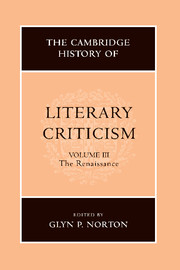Book contents
- Frontmatter
- Introduction
- READING AND INTERPRETATION: AN EMERGING DISCOURSE OF POETICS
- POETICS
- THEORIES OF PROSE FICTION
- CONTEXTS OF CRITICISM: METROPOLITAN CULTURE AND SOCIO-LITERARY ENVIRONMENTS
- VOICES OF DISSENT
- STRUCTURES OF THOUGHT
- NEOCLASSICAL ISSUES: BEAUTY, JUDGEMENT, PERSUASION, POLEMICS
- 51 Combative criticism: Jonson, Milton, and classical literary criticism in England
- 52 The rhetorical ideal in France
- 53 Cartesian aesthetics
- 54 Principles of judgement: probability, decorum, taste, and the je ne sais quoi
- 55 Longinus and the Sublime
- A SURVEY OF NATIONAL DEVELOPMENTS
- Bibliography
- Index
- References
53 - Cartesian aesthetics
from NEOCLASSICAL ISSUES: BEAUTY, JUDGEMENT, PERSUASION, POLEMICS
Published online by Cambridge University Press: 28 March 2008
- Frontmatter
- Introduction
- READING AND INTERPRETATION: AN EMERGING DISCOURSE OF POETICS
- POETICS
- THEORIES OF PROSE FICTION
- CONTEXTS OF CRITICISM: METROPOLITAN CULTURE AND SOCIO-LITERARY ENVIRONMENTS
- VOICES OF DISSENT
- STRUCTURES OF THOUGHT
- NEOCLASSICAL ISSUES: BEAUTY, JUDGEMENT, PERSUASION, POLEMICS
- 51 Combative criticism: Jonson, Milton, and classical literary criticism in England
- 52 The rhetorical ideal in France
- 53 Cartesian aesthetics
- 54 Principles of judgement: probability, decorum, taste, and the je ne sais quoi
- 55 Longinus and the Sublime
- A SURVEY OF NATIONAL DEVELOPMENTS
- Bibliography
- Index
- References
Summary
The title of this chapter may appear doubly anachronistic. On the one hand, the word aesthetics was first used by Alexander Gottlieb Baumgarten only in 1735. On the other, the philosophy of beauty and taste that it came to designate relates to a ‘system of the arts’ (literature, music, sculpture, architecture, painting centrally – with theatre and dance) that itself has been held not to have been established until well into the eighteenth century. No doubt the elements, theory, and practice that constituted the system developed over many years. But it is not evident that they owe anything very specific to ‘Cartesianism’ – let alone to René Descartes – and terms like ‘Cartesian aesthetics’ have mostly meant vague ideas about the adoption of certain concepts as source of inspiration and artistic guide. The intention of this chapter is quite different. First, it will show that sixteenth-century debates in what were once the sciences of the quadrivium raised most of the issues basic to what we now call aesthetics. Second, it will show that Descartes picked up these issues, giving them large place in his work: whence they became typical of debate about art in his time. So it will propose, thirdly, that the meaning of later aesthetic argument is seen more clearly through this Cartesian lens. In the eighteenth century Descartes's greatest impact may well have been in aesthetics. He ‘was not a man of letters’, wrote Edward Gibbon in 1761, ‘but literature is under deep obligation to him’.
- Type
- Chapter
- Information
- The Cambridge History of Literary Criticism , pp. 511 - 521Publisher: Cambridge University PressPrint publication year: 1999
References
- 1
- Cited by



